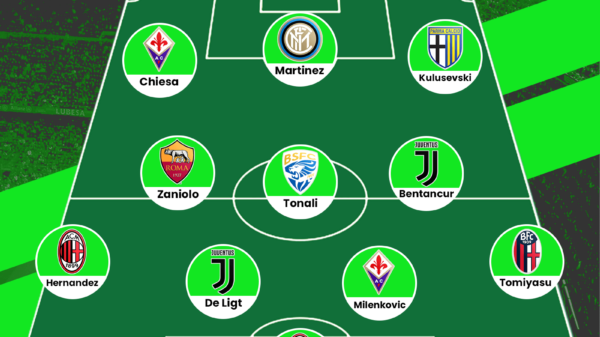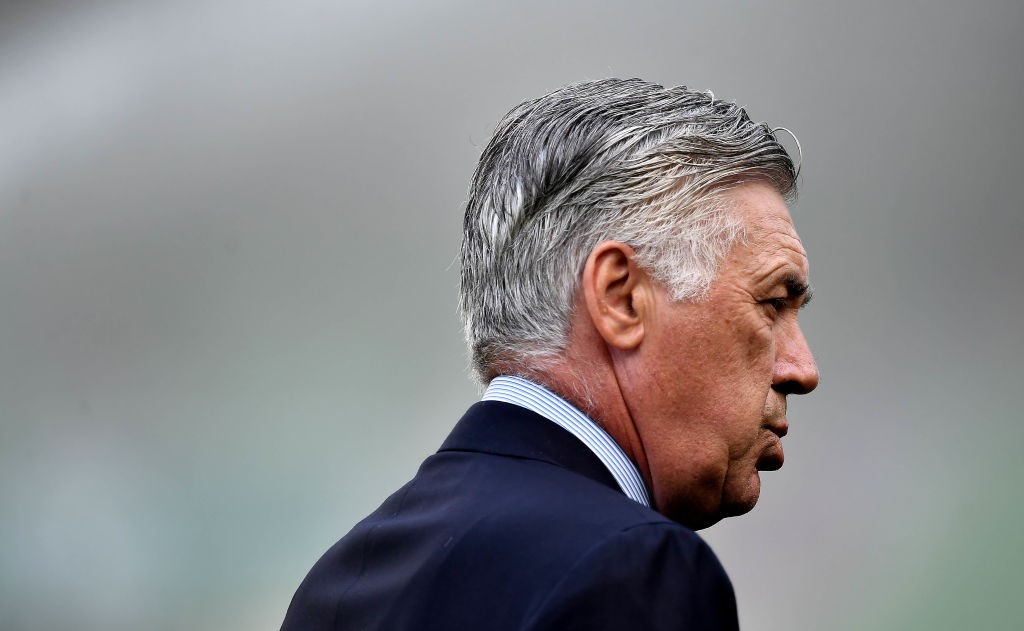Saiguhan Elancheran writes an analysis about how and why Juventus switched from their famous 3-5-2 formation to a 4-2-3-1.

Made using TacticalPad
Five consecutive Serie A titles, 2 Coppa Italia and great showings in the Champions League in the past five years have once again made Juventus one of the European elites after the Calciopoli scandal. Three numbers have been the key to their success in the past five years and they are nothing but the 3-5-2. The formation was introduced by Antonio Conte, who won three consecutive league titles with the club, and brought many laurels to the club. An oft forgotten formation in the sport which is dominated by the presence of 4-2-3-1, 4-4-2 and the 4-3-3, the 3-5-2 was even claimed to be reinvigorated by the Italian outfit through their brilliant results with this formation.
And of late, whenever Juventus played, 3-5-2 became the term associated with the team as this drew comparisons of tactics and teams that have been able to survive for a long period such as Sacchi’s Milan and their 4-4-2, Pep Guardiola’s Barcelona and so on. Allegri did well to stick with the same system left by his predecessor and also took them to greater heights in Europe in the 2014-15 season. The BBC and the central midfielders Pirlo and Pogba proved to be the most important factors deciding the success of this ploy and after their departures the team struggled a bit in terms of dominating the game and their defensive frailties were exposed especially in the current season. They have lost four times in the season and in all those four games, they played the 3-5-2. Allegri adopted formations such as the 4-4-2 and the 4-3-3 to find the right balance but he has found a new solution in the 4-2-3-1.
Let’s try and understand why Allegri has changed the very famous 3-5-2 of Juventus and how his team has performed after the tactical shift.
Weakness in the 3-5-2
One of the most important reasons that weakened the Juventus 3-5-2 is its long presence. The system had sustained for more than five years and teams started to exploit it by reading how Juventus play. Teams could easily analyse the defensive frailties in the system and this term they have lost four times when they played in this system. They have lost against the likes of Inter Milan, Genoa, AC Milan and Fiorentina. All these teams attacked them with pace in the wings. The main problem that comes up with this system is in the flanks when you play the back three.
Teams that generally play with pace will be able to dominate the full back pairs. In other cases, teams who play with two players in the wide areas, say a winger and full back, will dominate the wings in terms of numerical superiority. To help out, usually Barzagli and Chiellini would move into the flanks and this created holes(pockets of space in the middle) and players who arrived at pace in the centre could threaten from the same zone. These are certain tactical weaknesses in the 3-5-2.
Factors causing the change
Departure of Pirlo, Vidal and Pogba: Three of the most important players in the centre of the field for Juventus in the past five years have been Pirlo, Vidal and Pogba. It is important to hold up play and be in control of the centre in the 3-5-2 system and these three players have been one of the factors in deciding the success when using this system. All these players would feed the attackers with their long penetrating balls as well as win the defensive battles in the middle and also provide supplies to the next line of attack.
Absence of Marchisio: After spending six months out in the sidelines, Claudio Marchisio returned to the side only in the late October. It proved impossible for the team to cope with the 3-5-2 system without Marichisio at the centre as he has been the key player of the MVP which stood before the BBC. His quality was not adequately replaced by either Khedira or Sturaro. By the time he arrived, the team was quite naive when they went out with the 3-5-2 and it was understandable that it needed a change.
Arrival of new set of players: In the summer transfer market, there was a huge change in the script as Pogba left the club for a world record fee. Pogba was immense in their performance in the league as well as Europe and everyone felt that it was impossible for Juventus to replace him and they felt the heat in the opening months. Using the Pogba money, Juventus brought in different players which included the likes of Pjanic, Higuain, Pjaca and Dani Alves.
The arrival of Evra, Morata and Tevez in the beginning of the previous season made Allegri switch to a back four system on a few occasions, where he tried out the 4-3-3 and the 4-4-2. In the current season, with more attacking players such as Pjaca, Pjanic and Higuain coming into the fray, Allegri had to adjust to the best system to suit his players. By playing the 4-2-3-1, he can field all his attacking players in the same squad such as Higuain, Cuadrado, Dybala, Mandzukic and Pjanic.
Defensive set-up
Unlike most of the teams which revert to a 4-5-1 or 4-3-3-0 during the defensive phase, Juventus changes its shape to a 4-4-2 while defending. This particular shape is simpler than others and easy to execute. In this 4-2-3-1, the defensive strategy deployed by Allegri varies from that in 3-5-2 or the 4-3-3 as Pjanic and Khedria form the pivots in the centre. They do not boast great physical strength and they can be naive at times in the centre. To nullify this, Allegri uses two main strategies.
The two wingers on both the flanks drop back to join the double pivots to defend and the striker joins the attacking midfielder to form the two up top. This 4-4-2 shape is easier to defend and gets due help from the work rate of Mandzukic and pace of Cuadrado.
When the Juve players lose the ball high up the pitch, they will counter press the opponents immediately in order to reduce the overload on Khedira and Pjanic in the centre and try to delay the offensive transition.

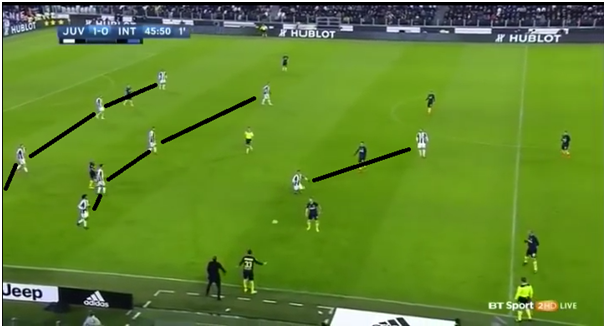
From the above two instances from the games against Sassuolo and Inter, we could identify the defensive set up used by Juventus. We can find Cuadrado and Mandzukic dropping to form the second line of defence with the double pivot.
This 4-4-2 set up is very narrow and compact. This is very important because the attacking players have to help out the pivots. They also cannot be more aggressive in pressing or chasing the opponents as it will leave them exposed at the back if the opponents can resist the pressure from Juventus. There are certain weaknesses in this set up as the attacking players have shown the tendency of fading away in the second half since they have to put in more effort in pressing the opponents.
Offensive set-up
In the offensive phase, wings have proved to be the great way for Juventus to kill the opponents. They often form overloads in the flanks with Dybala joining hands with Cuadrado and Lichtsteiner. In the games against Inter and Lazio, the break though from the wings caused havoc for the opponents with Cuadrado and Asamoah proving a great deal of threat with their pace. In most cases, Mandzukic stays with the midfield to provide his work off the ball where Asamoah or Sandro on the left flank would bomb up forward to become the outlet.
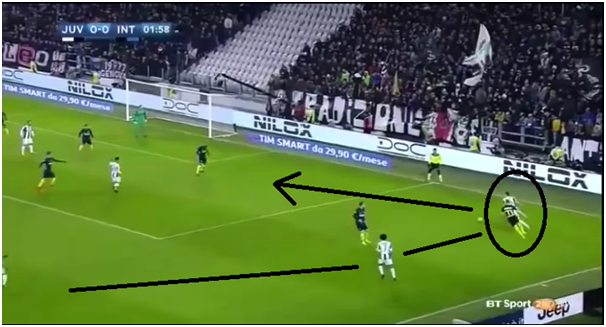
From the above instance we could indentify Cuadrado bringing Lichtsteiner high up the pitch. This is where their attacking play is based as the wing orientations prove to be the key in this system.
In other cases, the double pivot plays a key role in the offensive set up. The movements of Pjanic and link up play with Dybala prove to be decisive for the team. Also the ability of Chiellini to run forward with the ball and Bonucci’s ball playing skills to find Higuain upfront are certain factors that define the offensive set-up.
Mandzukic – Key to the system
Mandzukic could be stated as the most important player of this system given his contributions off the ball. Though he may not have a lion’s share in the team’s goals and assists, but his off the ball movements, creation of chances and most importantly the defensive work he does for the team have been impressive. His work rate overall for the team has improved very well and can be seen in this formation. In the games against Sassuolo, Lazio and Inter, his efforts were quite notable.
Juventus since the change
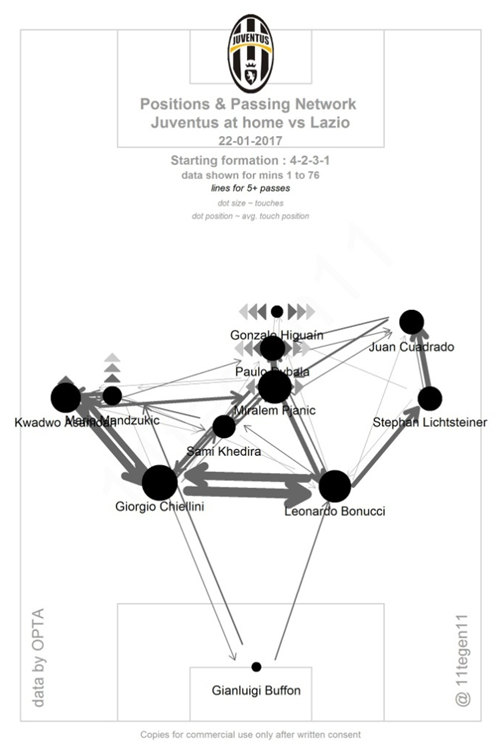
via @11tegen11

via @11tegen11
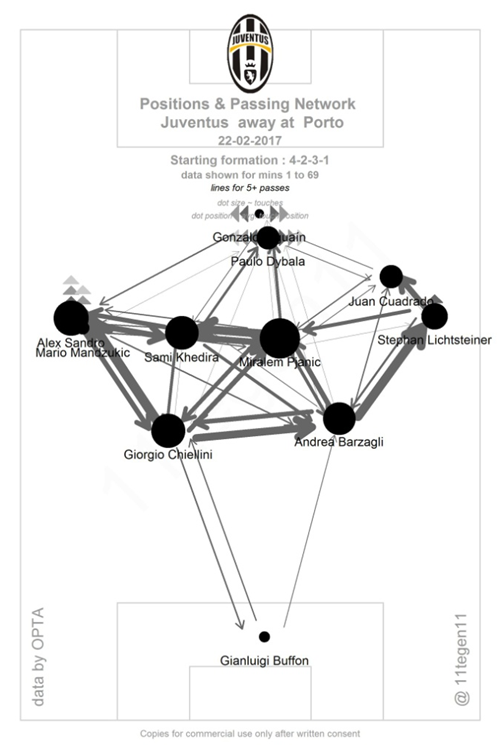
via @11tegen11

via @11tegen11
Since the changes from the game against Lazio, Juventus have featured in the 4-2-3-1. From the above images, we can see the different sets of players used by Allegri against different teams but the system used here is the same. We can see the importance of Cuadrado in the side as he becomes the farthest player in the team as the team often releases the ball through to him in the final third.
In the game against Napoli, Juventus started with the 3-4-3 formation in order to counter Napoli but were not quite successful in doing it. In the second half, Allegri reverted the side back to 4-2-3-1 by bringing in Cuadrado. This tactical shift helped them score 3 past Napoli in the second half and win the game 3-1.
Conclusion
Though not among the elite coaches like Guardiola, Mourinho and Conte for tactical nous, Allegri is certainly one coach who should be praised for showing courage to change a system that has brought them numerous laurels in the recent past. Just by understanding the strength of the team and needs to be fulfilled, he has done a great job to bring in the right mix and fit the best players in his eleven. He also found that he needed a new system in the team as it would bring in the much needed spark and rejuvenate the side which has seen them go out and play the same way game in game out. One may blame him for not bringing in the change as early as there were signs indicating the downfall of the 3-5-2 at the Juventus Stadium but he has stood up to his task as a manager and has rung in changes at the right time. Having seen this new system at Juventus showing great deal of potential to reach heights, we can expect the team to once again win the Scudetto and they may even raise everyone’s eyebrows by going for the treble as well.
























































